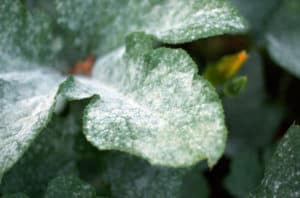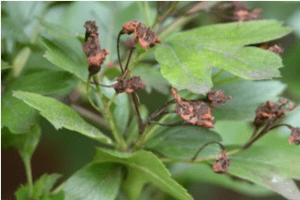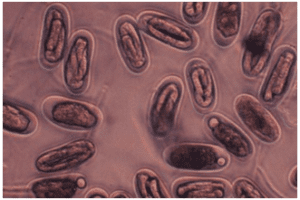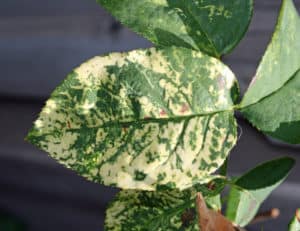25 Jan Picking the Ick out of your Landscape: Identifying Shrub Diseases
Similar to humans, when the needs of shrubs are not met, a decline in health will result. You can begin by narrowing your prognosis by eliminating improper growing conditions or shrub pests. Once you are certain your shrub isn’t being eaten by bugs or animals, you can move on to analyzing the type of disease. When diagnosing shrub diseases, there are two categories for which your “ick” will be classified under: abiotic or biotic. Abiotic diseases are man-induced diseases that involve non-living factors such as lack of space for root growth, prolonged levels of water toxins, or extreme heat, light or soil pH levels. This article will focus on biotic diseases of woody-shrub diseases that are scientifically or biologically-induced, such as fungi, bacteria, viruses and nematodes.
Identifying the disease in woody-shrub fungus materials.
Begin first by narrowing the market. Eliminate pest and poor growing conditions by looking for gnawing marks or stripped leaves, which will indicate rodents such as rabbits or deer.
It’s important to note that you should identify your infected shrub first as not all diseases affect one type of plant. This will help narrow down your market of diseases to choose from. Be sure to check the trunk, leaves, branches and roots to note the specific symptoms your shrub is suffering from. There are numerous types of shrub diseases, which makes it impossible for this article to fully diagnose and treat each one. Our team of horticulture specialists have identified the top most common biotic diseases and symptoms of what to look for when diagnosing your sick shrubs and how to treat each disease.
Fungus: “Powdery Mildew Fungus”
This common type of disease is a fungal growth that leaves a white powder on surfaces of shrub foliage.
Treatment
- Remove parts of shrub that infected with disease
- Prune shrubs to improve air circulation
- Hold off on all fertilization until the disease has been altered and the plant health has improved
- Water shrub from under the plant in order to reach roots directly
- Finally, apply a fungicide (tip: the average fungicide will need to be re-applied 7-14 days after your shrub disease diagnosis to ensure the health of the shrub is rectified.)
Bacteria: “Fire Blight”
This common type of bacteria leaves twigs and branches on shrubs wilt and blackened. Oftentimes the affected branches will bend over into the shape of a shepherd’s crook.
Treatment
- Dormant season: prune infected areas of shrub
- Tip: Be sure to clean pruning tools in-between shrub cuts
- Growing season: refrain from pruning shrubs due to chances it could spread the disease, instead remove infected shrubs from landscape
Nematodes
Symptoms include browning shrubbery and vegetation, which may cause undergrowth to die and/or fall off the plant. Root systems will be affected and plant growth will be stunted.
Treatment
- Do not use a chemical application to treat plants
- Remove infected plant from landscape
- Protect other shrubs through water and fertilization
Virus: “Rose Mosaic Disease”
You will notice signs of this virus if your shrub experiences color changes in its leaves, specifically a mosaic pattern of light or dark greens. Additional symptoms and signs include stunted growth and uncommon color changes.
Treatment
- Remove infected shrub to prevent the spread of disease
- Tip: It’s important to be on top of insect management because Rose Mosaic Disease can spread through your landscape from insects feeding on additional health plants.
Regardless of your diagnosis, we recommend sending a sample to a clinic that specializes in plant disease, such as your local agricultural extension office, to ensure proper identification due to the extensive line of fungicides and treatments available for shrub disease.
Prevention.
Oftentimes it feels like our focus on the health of our plants and landscapes in general strays after the summer months fade. It’s important to remember to be proactive to prevent shrub disease throughout the year. We recommend awareness of the following points:
- Proper air circulation and ventilation
- Use of native plants (planting the right plant that will survive in the culture of your landscape, i.e. choosing shrubs that will withstand the harsh winter temperatures or extreme heat during the summer months of your locality)
- Proper sunlight
- Be sure water is not sitting on the leaves of the plant
- Plant resistant cultivars (plant disease resistance will protect plants from pathogens)
Keeping the ick out of your landscape.
It’s important to monitor the health of your shrubs during all seasons of the year. There are multiple varieties of abiotic and biotic diseases than can infect your shrubs. Proper air circulation, sunlight, pH in soil levels and clean water will help to keep the “ick” out of your landscape. When in doubt, be sure to consult an industry expert to kick the “ick!”






